On 12 November 2021, from 11:30-13:00, the 3rd Xi Xian "Innovation Cloud Forum", co-organised by the IIDPF and the Centre for Science and Technology Strategy and Policy Research, affiliated with the Ministry of Education and the Ministry of Science and Technology, was held online as scheduled. Professor Zhang Lin, Director of the Center for Management and Evaluation of Science and Education at Wuhan University, was the guest speaker, presenting a lecture entitled "Are Women Scholars' Research 'Less Influential'? ". The forum was organised by the Science and Technology Strategy and Policy Research Institute. More than 100 students and teachers from Wuhan University, Dalian University of Technology, Renmin University of China, Huazhong University of Science and Technology, Zhongnan University of Economics and Law and other universities attended the forum online.
  Professor Zhang Lin's presentation focuses on a recent article published by her team in Scientometrics: Gender differences in the aims and impacts of research. The article analyses how the impact of research published by academics differs between genders and how this difference in impact can be explained. How can this difference in impact be explained?
  I. Background
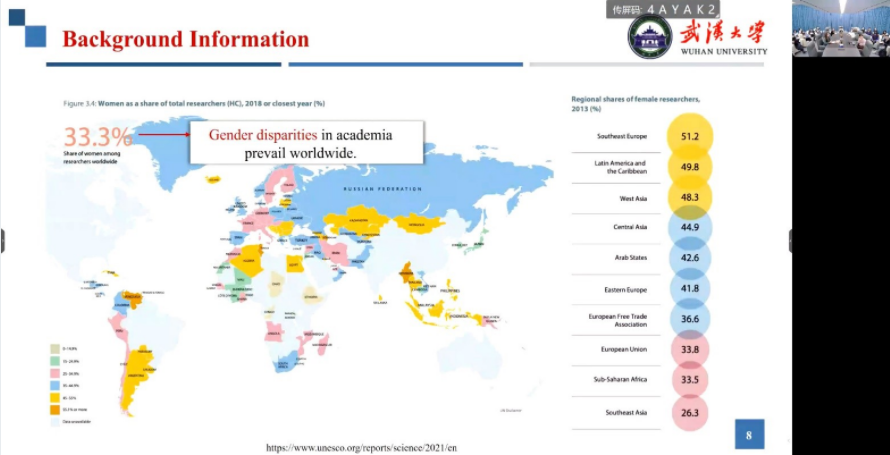
  Academia is a field where gender disparities are significant and typical. In terms of the percentage of academics, the latest statistics for 2018 show that female academics account for only 33.3% of all academics worldwide, and although this proportion has been increasing, only a third of academics are still female, and there are significant differences in the distribution of female academics across different regions, with Southeast Asia having the lowest percentage of female academics at 26.3%.
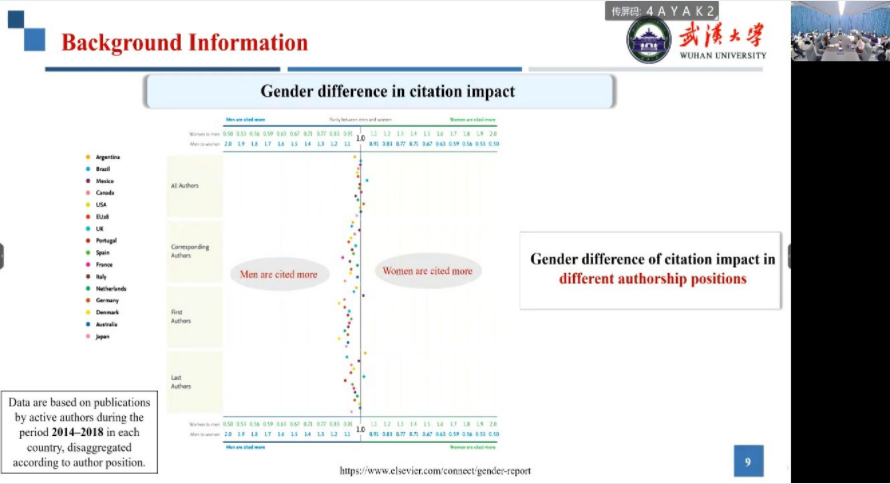
  In terms of the citation impact of papers, citations are 'lopsided' across all author types in most countries, reflecting a clear predominance of male academics. As a result, the influence of female academics is also relatively low.
  II. Causes
  Professor Zhang Lin summarised the studies that have been conducted on the causes of differences in the productivity of papers and papers cited by different gender authors. The productivity of female scholars is mainly affected by the following aspects: (1) Family burden, as female scholars often have the responsibility and obligation to take care of children. (2) Career trajectories, where the 'prime' of women academics' careers coincides with childcare, leading to a 'pipeline effect' where women are underrepresented in higher positions. (3) International cooperation, women are relatively disadvantaged in terms of mobility in international exchange and cooperation due to the heavy social burden. (4) Reviewer factor, most reviewers are men, so there may be some gender discrimination in the review. (5) Teamwork, women are not at an advantage in forming teams. (6) Interpersonal networks. It has been suggested that female academics are not good at managing social relationships, so their interpersonal networks are weaker in the academic community.
  In terms of citations to papers, citations by female scholars are relatively lower than those by male scholars. It has been suggested that the main reasons for this are as follows: (1) Male scholars are inherently more productive than female scholars, and therefore have a relatively higher citation rate. (2) Male academics self-cite more often, i.e. male academics are somewhat more self-approved. (3) The problem of gender discrimination in academia.
  With the pre-existing results, this study hopes to understand if there are other factors that influence the output and impact of female academics' papers.
  III. Data sources
  To expand the conceptual scope of 'impact' and break the limitations of 'citation impact', this study extends the measure of impact from citation rate to online communication, using the number of social media communications, the number of abstracts or full-text reads, and the number of news blogs The study extends the measure of citation impact from citation rates to online communication, using the number of social media communications, the number of reads of the abstract or full text, and the number of retweets on news blogs as additional measures of citation impact. There are three main sources of data for the articles: (1) Web of Science (number of papers with Norwegian scholars as first authors from 2011-2017, 26,976 in total) (2) Plum Analytics (social media dissemination data, i.e. number of reads, retweets) (3) Norwegian Science Index (precisely matched 11 The Norwegian Science Index (which accurately matches the basic information of 11,725 Norwegian academics, 57% of whom are men and 43% of whom are women). As a result, the article obtains more accurate data information about the authors' gender, age and subject area, as well as the frequency of citations of their papers, and the number of readings and dissemination on social networking platforms.
  The gender distribution of academics is uneven overall across the four main subject areas. The highest proportion of female academics and the most balanced gender distribution is found in biomedical sciences; the most imbalanced gender distribution is found in natural and engineering sciences, where only 27% of academics are female.
  IV. Research Methodology
  This study employed four different methods to examine the same issue from different perspectives, including citation analysis, alternative metrics analysis (Altmetrics analysis), questionnaires and textual analysis methods. The specific methods used in the citation analysis and altmetrics analysis include: (1) Normalization of impact indicators. For the number of citations, the article benchmarks the average number of citations published in the same subject area in the same year globally. For online dissemination, the article benchmarks the average number of reads and retweets of more than 80,000 papers published by Norwegian scholars (in the same year, in the same subject area, and in the same literature type) on the Internet, and obtains a standardised score, thus achieving comparability across all subject areas. (2) RelativeIndicator (indicator) adoption. In this paper, a percentage indicator (PR) is used, i.e. all papers in each field are ranked from highest to lowest under each indicator, and the top 10% are extracted, and then the ratio between the percentage of each group of authors in all samples and the percentage in the top 10% is calculated, if the value is greater than 1, it means that the percentage of this group of authors is higher than their percentage in the overall under this indicator, reflecting their relative advantage.
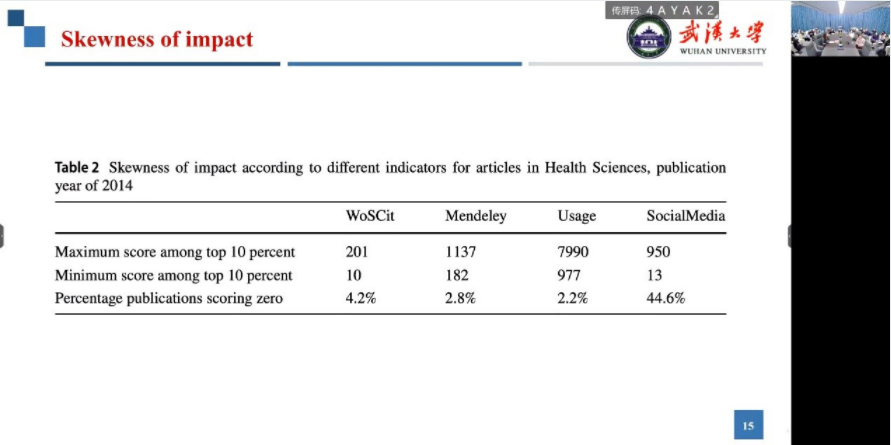
  In addition, the article explains the reasons for using the top 10% indicator. As shown in the table above, under the four indicators, there is already a quantitative difference between the very large and very small values of the top 10% of papers due to the biased nature of the data distribution, with the top 10% essentially reaping more than half of the impact of all papers, and given the existing evaluation orientation, the relative share of the highest impact papers has been selected as the core indicator for measurement comparison.
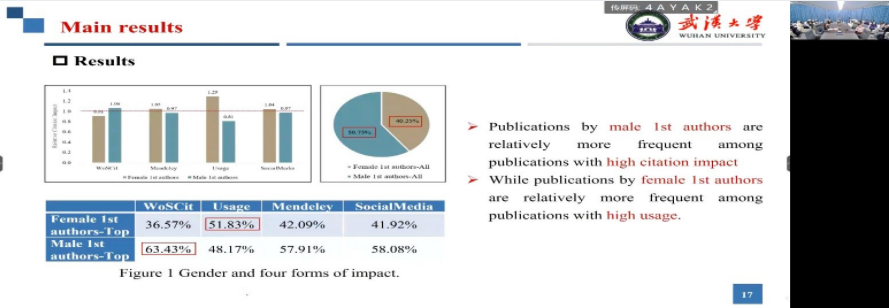
  V. Research findings
  As shown in the figure above, the article first draws the following findings: (1) Papers with men as first authors account for 59.75% of the total number of papers, while female scholars account for 40.25%, reflecting the basic distribution ratio of papers. (2) There are significant differences in the performance of the four impact indicators by gender, particularly WoSCit and Usage. papers published by male first authors have a higher relative share advantage in the most highly cited (WoSCit) papers, while papers by female first authors have a significant advantage in the most read papers. Differences in the impact of papers by gender of academics all passed the significance test.
  (3) Further subgroup analysis revealed that under different age groups, female scholars were weaker than male scholars in terms of citation impact, but were all higher than male scholars in terms of the number of abstracts read.
  (4) In addition, a further breakdown by subject area reveals that within different subject areas, the number of abstracts read by female scholars is higher than that of male scholars, even in the natural and engineering sciences, which are overwhelmingly dominated by male scholars.
  VI. Discussion
  Regarding the above findings, the article first tried to analyse them from the following perspectives. First, from the perspective of self-citation, the article hypothesised that self-citation was the reason for the high citation rate of male scholars. However, after careful data analysis, it was found that self-citation was not a key factor. Secondly, from the perspective of scholars' research fields, the article hypothesised that female scholars' greater tendency to work in subject areas that interact with society (i.e. biomedical fields, social and humanities fields) was responsible for the high number of their abstracts being read, but after data analysis, it was found that differences in subject areas worked by scholars of different genders could not explain the phenomenon found in this article either.
  In conclusion, based on the manual reading of hundreds of article abstracts in the sample, and taking into account theories such as "basic research is more highly cited than applied research" found in the existing literature, the article attempts to propose a hypothesis from the perspective of differences in research questions and content: male scholars are relatively more concerned with research that addresses "scientific problems", while female scholars show a stronger preference for research oriented towards "social problems". scientific problems", while female scholars show a stronger tendency to focus on "social problems". The difference in gender bias in this dimension may have contributed to the difference in the impact of the results of scholars of different genders. To support this hypothesis, the article uses the 'research purpose' of all abstracts as a measure, and the authors manually read 1,193 abstracts of 'high-impact' papers from different disciplines back-to-back (high-impact papers include highly cited, highly Based on the results of multiple rounds of comparison and discussion of the manual annotations, all papers were classified into three categories based on the research aims explicitly stated in each abstract: Scientific progress (aimed at solving academic problems), Social progress (aimed at solving social problems), and Combined aims (aimed at solving both problems). Combined aims (solving both problems at the same time).
  VII. Conclusion
  Following further detailed analysis of the data, the article draws the following conclusions: (1) Highly cited and highly read papers show significantly different distribution trends. Highly cited papers are more oriented towards solving scientific problems, while highly read papers are more oriented towards solving social problems. (2) A relatively higher proportion of papers with men as first authors are oriented towards solving scientific problems, while a relatively higher proportion of papers by female academics are oriented towards solving social problems. (3) Combining these two findings can help us to explain the differences in the impact of papers by gender authorship.
  The article continues with a questionnaire to explain why this phenomenon has occurred. Using a questionnaire, it explains the reasons for this phenomenon from the perspective of the initial motivation, purpose and value of research of different genders of scholars. Based on the results of a questionnaire survey of 2587 researchers in five European countries, the following conclusions are drawn: (1) In terms of research motivation, female scholars are more likely to choose "creating a better society" and "Inspiration from users", i.e. female scholars are more likely to focus on the value of research. users", i.e. female scholars are more concerned with the social impact and value of their research. (2) In terms of evaluating the value of research, a greater proportion of female scholars believe that the best research should be beneficial to society. From this, it can be seen that while male and female academics are consistent in their focus on scientific progress (both vote highest), female academics may be more likely to add a social perspective to their research and to take more ownership of and participate in social problem-solving-oriented research, resulting in female academics' papers being more widely read by the public but relatively less cited in the academy.
  In conclusion, the article summarises the core innovation of this study: for the first time, the classic questions of 'gender and academic performance differences between scientists' and 'different types of research and impact performance differences' have been cleverly linked, and an intrinsic link between these two classic questions has been discovered. It provides a new explanatory perspective for the study of gender differences in scientists and is systematically justified on the basis of four different research methods. At the same time, the policy implications of the research findings are interpreted, and the current dominant evaluation model of "citation impact" at home and abroad is reflected upon, suggesting that research evaluation should effectively take into account different purposes, types and impact performance of research results, and focus on the "social impact" of scientific research. "It also suggests that the gender differences of scientists should be better understood from a broader perspective to support relevant science and technology policies.
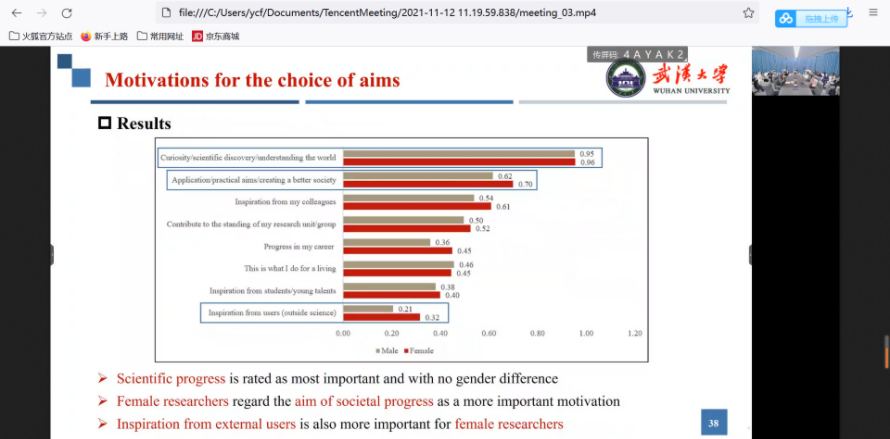
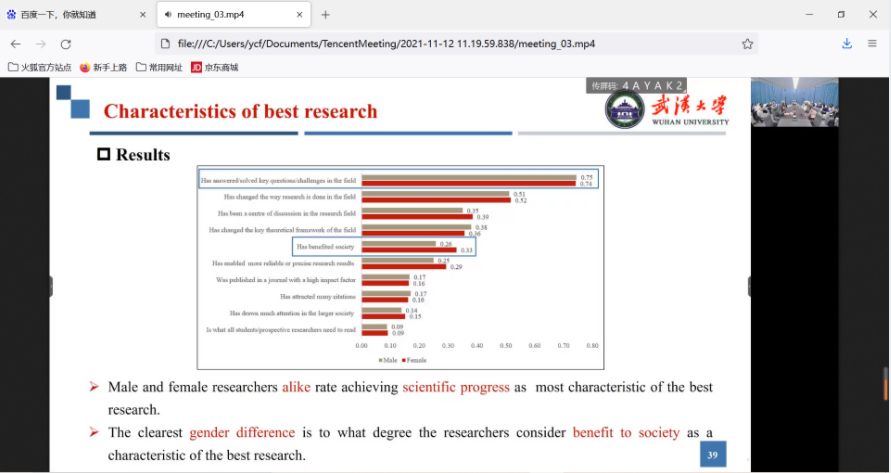
  VIII. Interaction
  After explaining the paper, Professor Zhang Lin shared her insights on scientometrics. Firstly, she pointed out that the core issue of scientometrics is to reveal the intrinsic laws and characteristics of scientific activities through quantitative methods, and that its disciplinary origin is not directly related to research evaluation. Although scientometrics can support and serve the needs of evaluation based on objective research results, it is not advisable to put the cart before the horse. Secondly, there should be more cooperation and exchange between scientometrics and other disciplines, and it is recommended that in the future, there should be a shift from research on "what" to research on "why" and "how". Thirdly, scientometrics needs to interact more substantively with actual policy needs, rather than superficial data analysis.
  The talk concluded with an active discussion between students and faculty on machine learning identification, other causes and measures of gender differences in paper publication.
